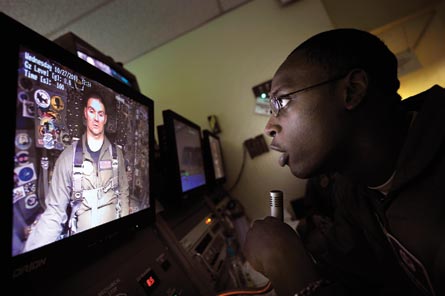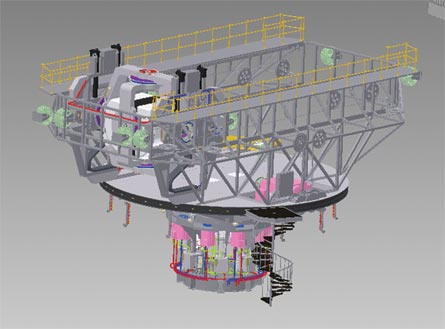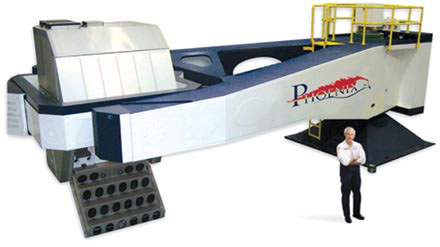More than 100 years after man's first ascent in powered heavier-than-air machines, scientists still do not grasp some failures of the biological partner in this symbiotic coupling - the pilot.
"We haven't fundamentally come to understand what causes certain events, such as visual illusions," says Cmdr Rita Simmons, executive officer of the naval medical research unit in Dayton, Ohio.
Visual illusions, which can lead to spatial disorientation and motion sickness, are among the top safety concerns for military aviators. Simmons says a new US Navy-funded study, not yet released, reveals that between 2000 and 2005 spatial disorientation alone cost the USN $175 million in lost equipment, lives and missions compromised.
|
|---|
On the surface, the base's new simulators appear to be rides in some sort of sadistic amusement park. There is the vertical linear accelerator, a device that oscillates pilots at two cycles per second (2Hz) like a salt shaker; the visual vestibular sphere device, a 3.6m (12ft) diameter sphere that can rotate at 30rpm around a rider strapped in a chair at its centre; human-rated hypobaric chambers that cycle temperature from -55ºC to 65.5ºC (-67ºF to 150ºF), some large enough to hold a Humvee-sized truck; a $34 million gimballed ATFS-400 centrifuge with a 9.4m swing arm that can whip riders in a 9g arc for g training and research; and a massive $20 million disorientation research device called Hercules that can twist and spin its occupants to the point of total confusion.
But every "ride" is designed to further the military's knowledge on various topics and to boost safety, mission readiness and completion.
Such training and research used to be handled by the services separately, but base realignment and closure exercises dating to the 1970s have progressively brought the whole "school house" to Dayton. Since 2005, the air force has consolidated its aeromedical operations largely under the 711th Human Performance wing at Dayton and the navy is setting up an aeromedical centre of excellence there. Buildings at the new centre are almost ready for habitation, with devices being installed over the next two years. Full-up operations are expected to begin in 2013.
|
|---|
Equipment is being packed up and moved to Dayton, including altitude chambers and the navy's visual vestibular sphere device. Capable of rotating at 30rpm, the device allows a test subject in a pedestal stool to sit stationary in the full immersion environment, or be tilted and rotated independently from the sphere.
"We are looking to stimulate illusions and interactions between the vestibular system [which controls equilibrium, sense of balance and orientation] and the inner ear [home to the body's motion sensors]," says Simmons.
Most of the equipment is new and improved. Philadelphia-based Environmental Tectonics (ETC) has completed the critical design review of a new centrifuge for the USAF that will include three interchangeable gimballed cockpits simulating the Lockheed Martin F-22, F-35 and Boeing F-15 fighters. By controlling the acceleration and speed of the rotating arm and orientation of the cockpit module, the military can simulate g-based flight with the ATSF-400. The cockpits are also fully functional flight simulators, with a 210e_SDgr field of view screen and reconfigurable touchscreen displays.
Col James Weissmann, chief of the aerospace medicine education division at Brooks AFB, says the ATSF-400 second-generation multi-axis centrifuge will be used for about 75% of its operational time for initial and refresher anti-g straining manoeuvres for pilots, and 25% for research. Air force fighter pilots must be able to maintain consciousness with no tunnel vision through 15s of 9g acceleration. Until October, the air force's g training was erformed with a first-generation centrifuge - which applies the g force in only one direction - at Holloman AFB in New Mexico.
A navy centrifuge at Lemoore NAS in California will remain operational for g training for maritime pilots and provide a back-up for the air force once the ATFS-400 goes operational in 2012, says Weissmann. Meanwhile, the air force is using a centrifuge at Brooks AFB in Texas to provide interim g training.
The ATFS-400 has a cockpit module in nested cradles (multi-axis) that will allow for flight-like g cues, a capability the air force will explore in measured steps. "Having multiple gimbals opens the door to look at other issues," says Weissmann. He says that testing to date has looked only at the effects of g force in the Z, or downward, direction (forces that, in a tight turn, push a pilot into the seat pan), but with thrust-vectoring aircraft such as the F-22, there can be an off-axis g-force component. "We don't know the effects," he says, adding that issues may arise when the air force begins using the aircraft to its full capabilities in an operational dogfight environment. "We don't have anything on the drawing board yet for a research plan," he says.
The US Navy says its new vertical linear accelerator, built with government small businesses innovation research funds, is complete and being installed at Dayton. The device has a chair with a display screen that travels up and down a 3.66m-long I-beam to study vertical motion environments, for instance in helicopter research. The chair can move at rates of up to 2Hz, exerting up to 2g of force on the subject. "A lot of the research is for helicopters and then some very specific things we might want to look at," says Simmons, adding that the device could be used to study visual/vestibular interactions for any vehicles "with vertical motion" - the F-35 VSTOL variant, for example.
Then there is Hercules. Officially the ETC GL-6000 Gryphon, this will help the navy to better map out the links between the central nervous system and the vestibular system - the two workings of the body that are believed to be responsible for spatial disorientation and its counterpart, motion sickness.
"We don't know why people get motion sickness," says Simmons. "If theories are correct, the central nervous system and vestibular system are part of that, but it is difficult to study."
Hercules will help. The simulator has four axes of rotational motion - roll, pitch, yaw and planetary - as well as vertical and horizontal translation of +/-0.9m and +/-5.2m, respectively, for sustained acceleration levels of +/-3g "in all axes of motion at all times", says ETC. The cabin includes a visual display system that can translate from 12.5mm (5in) from the test subject's eyes to 90cm away.
Some of the first investigations on Hercules will introduce "disorientating scenarios" and collect vestibular information, Simmons says. Also of interest is a look at the effects of hypoxia under g-influenced scenarios. "If we're trying to explore spatial disorientation, we can provide an actual environment with visuals and get physiological monitoring information back," says Simmons.
All these devices should bring unity to aeromedical research between the forces once operations begin and capabilities are assessed. Simmons adds: "New technology may allow us to start looking at the cellular level - what is happening inside the brain. When we begin to understand that, we may be able to understand some of these problems. We can start teasing these things out, hopefully in the near term."
|
|---|
Source: Flight International


























